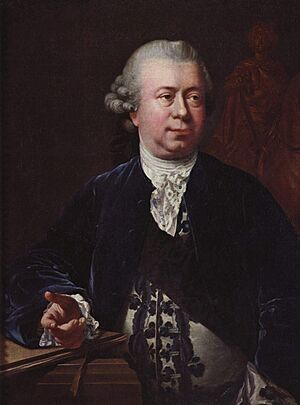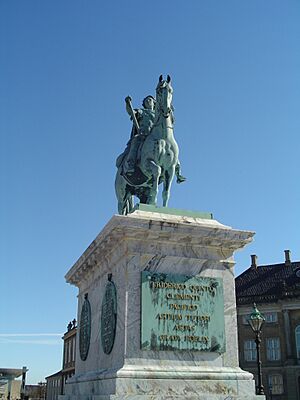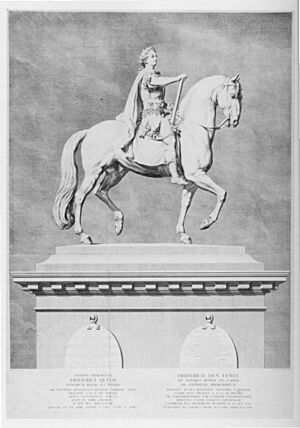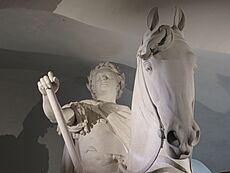Jacques Saly facts for kids
Jacques François Joseph Saly (born June 20, 1717 – died May 4, 1776) was a famous French sculptor. He worked in France, Italy, and Malta. However, he is best known for his time in Denmark. There, he was the Director of the Royal Danish Academy of Art from 1754 to 1771. His most famous artwork is the large statue of King Frederik V on Horseback at Amalienborg Palace.
Contents
Life of a Sculptor
Early Training and Career
Jacques Saly was born in Valenciennes, France. He started learning sculpture at just nine years old, studying with a local master named Antoine Gilles. Even though his family didn't have much money, he moved to Paris in 1732. There, he trained with Guillaume Coustou, one of the top sculptors in Paris at the time.
Saly also attended the school of the Académie royale de peinture et de sculpture. This was a very important art school. He won several medals there in 1734, 1737, and 1738.
His last medal was first place in the Prix de Rome competition. This prize allowed him to study at the French Academy at Rome. This was the best way for a young sculptor to become successful in Paris. Saly received his scholarship in 1740 and arrived in Rome on October 13, 1740. He lived at the Academy for eight years, until 1748. The main goal was to learn from ancient Roman sculptures and famous artists from the past. This helped artists improve their style. Saly also made marble copies of Roman sculptures for the French king.
While in Rome, Saly created a large portrait bust of Manuel Pinto de Fonseca, who was the Grand Master of the Order of Malta, in 1742. In 1744, he made a bust of a little girl. This sculpture became one of the most popular from the 18th century. Saly also became a member of several art academies in Italy, including the Accademia degli Arcadi in Rome and academies in Florence and Bologna.
Returning to Paris
Saly traveled back to France through Naples, Florence, and Bologna. He arrived in his hometown of Valenciennes in March 1749. His sculptures that he had sent home were so well-liked that his hometown asked him to create a full-size statue of King Louis XV of France. The marble statue was put up in 1752, but it was later destroyed in 1792 during the French Revolution. He also made a plaster bust of King Louis XV that same year.
Saly then moved to Paris. In 1751, he became a member of the Académie royale de peinture et de sculpture with his sculpture called Le Faune au chevreau. He worked as an assistant professor at the Académie from 1751 to 1753. He also showed his art at the famous Paris Salon exhibitions in 1750, 1751, and 1753. In 1752, he created a plaster bust of Madame de Pompadour, a very influential woman at the French court. The next year, he made a statue of Amor for her.
Called to Denmark
In 1752, Saly received a very important job offer. He was asked to create a large sculpture of King Frederick V of Denmark on horseback. This statue was meant to be placed in the main courtyard of Amalienborg Palace in Copenhagen. The Danish Asiatic Company paid for the statue as a gift to the king. Even though the company paid, the government chose Saly as the sculptor.
A Danish diplomat in Paris, Justitsråd Joachim Wasserschlebe, was asked to find a suitable French sculptor. Another famous sculptor, Edmé Bouchardon, turned down the offer but suggested Saly. Saly agreed, but he asked for a lot of money for the model and free housing in Copenhagen. The Danish government signed the contract with Saly in the spring of 1752. However, Saly had other projects he was working on, so he didn't arrive in Denmark until October 8, 1753. He brought his parents, two sisters, and at least one assistant with him. Work on the huge statue began that same year.
Leading the Academy in Copenhagen
Around the same time, the Royal Danish Academy of Art (Det Kongelige Danske Kunstakademi) was officially opened. This happened on King Frederik V's birthday, March 31, 1754, at Charlottenborg Palace. Saly gave the main speech at the opening event. He was made a member of the Academy, became a professor, and received a home at Charlottenborg.
A few months later, the Academy's director, architect Nicolai Eigtved, suddenly died. Saly was chosen to take his place. He served as the Director of the Academy from July 25, 1754, to July 15, 1771. In 1760, he was given a lifelong yearly payment. Saly worked very hard to improve the Danish Academy. He wanted it to be as good as the French Academy. He made these changes while also working on the large equestrian statue for the king. This statue became the most important artwork of his many years in Denmark.
Saly also helped bring his friend, architect Nicolas-Henri Jardin, to Denmark. Jardin was from France and had studied with Saly in Italy. Saly suggested Jardin to King Frederik V as the best person to design and build Frederik's Church (now known as The Marble Church). Work on this church had started in 1749. Jardin signed a contract to come to Denmark on October 12, 1754, and he took over Eigtved's professorship at the Academy.
The King and His Statue
Saly showed the king his first drawing of the equestrian statue on December 4, 1754. The king approved the overall design in August 1755. Then, Saly spent time carefully studying horses from the king's stables. This led to a small model of the statue, which he showed the king in November 1758. Copies of this model can be found in art collections today, including the Danish National Gallery. Saly also sculpted a life-size bust of the king, and seven bronze copies were made. He also sculpted a statue of Moltke, the head of the Asiatic Company.
Saly set up a special studio to work on the large model of the equestrian statue from 1761 to 1763. The plaster cast of the statue was shown to the Academy members on February 3, 1764. The king also saw this model. It took four more years to prepare for the bronze casting. A Frenchman named Pierre Gors did the casting on March 2, 1768. The year 1768 is officially considered when the statue was finished.
Johan Martin Preisler made a large engraving of the equestrian statue in 1768-1769 to celebrate its completion. The Danish Asiatic Company also made two medallions to honor the statue.
However, the base for the statue was not ready until 1770. The grand unveiling of the equestrian statue finally happened in the courtyard at Amalienborg Palace on August 1, 1771. This was five years after King Frederik V had died in 1766. The statue still stands there today and was restored in 1997-1998.
Leaving Copenhagen
Saly remained Director of the Academy until July 15, 1771, just two weeks before the statue was unveiled. He resigned because of new rules that gave more power to Danish-born artists. This happened during the time of Johann Friedrich Struensee's reforms in Denmark.
Saly was named a Knight of the Order of St Michel in Paris. However, he was not allowed to use this title while living in Denmark. Even after leaving his director role, Saly kept his apartment at Charlottenborg until at least 1774. During this time, he tried to get more money from the Danish Asiatic Company for his work on the Frederik V monument. He felt he deserved more because the statue took much longer to finish than planned. He was not happy with the final financial agreement.
Final Years in Paris
Saly left Denmark for Paris with his father on July 2, 1774. Most of his other family members had passed away by this time. Back in Paris in 1775, he was finally able to use his title of Knight. He was named Senior Professor at the French Academy in Paris on July 29, 1775. Saly was already very sick when he left Denmark, and he died on May 4, 1776. He was buried at Saint-Germain l'Auxerrois.
Saly's Legacy
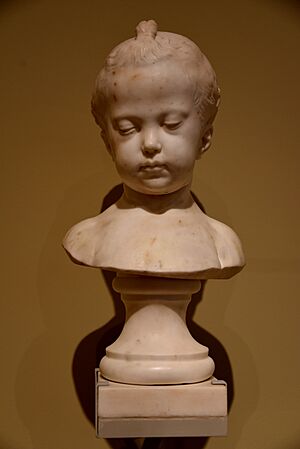
Jacques Saly's greatest artistic achievement is the huge equestrian statue of Frederik V of Denmark. His important role as the first Director of the Royal Danish Academy of Art helped make the Academy a leading art school in Europe. This also helped create a strong Danish art tradition.
Besides the academies mentioned earlier, Saly was also a member of art academies in Marseilles (1762) and St. Petersburg (1768).
His sculptures can be found in many famous museums around the world. These include the National Gallery of Denmark (Copenhagen), National Gallery of Art (Washington D.C.), Musée du Louvre (Paris), Musée des Beaux-Arts (Valenciennes, France), and the J. Paul Getty Museum (Los Angeles, California). Some of his works are also in private collections.
See also
 In Spanish: Jacques Saly para niños
In Spanish: Jacques Saly para niños
- Art of Denmark
- Danish sculpture
Related reading
- Henry Jouin (1896) Jacques Saly, de l'Acad. de peinture de Paris: sculpteur du voi de Danemark (Bureaux de la Gazette des Beaux-Arts)
- Bent Sorensen(1995) L'éléphant de Jacques François Joseph Saly (Gazette des beaux-arts)


